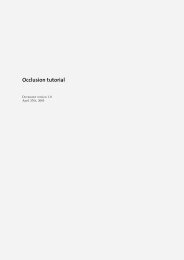mental ray Architectural and Design Visualization Shader Library
mental ray Architectural and Design Visualization Shader Library
mental ray Architectural and Design Visualization Shader Library
Create successful ePaper yourself
Turn your PDF publications into a flip-book with our unique Google optimized e-Paper software.
2.6 Tips <strong>and</strong> Tricks 49• For extremely blurry surfaces or surfaces with very weak reflections, try using therefl hl only mode.A typical wooden floor could use refl gloss of 0.5, refl samples of 16, reflectivity of 0.75,a nice wood texture for diffuse, perhaps a slight bump map (try the no diffuse bumpcheckbox if bumpiness should appear only in the lacquer layer).A linoleum carpet could use the same but with a different texture <strong>and</strong> bump map, <strong>and</strong> probablywith a slightly lower reflectivity<strong>and</strong> refl gloss.2.6.2.2 CeramicsCeramic materials are glazed, i.e. covered in a thin layer of transparent material. They followsimilar rules to the general materials mentioned above, but one should have brdf fresnel on<strong>and</strong> the refr ior set at about 1.4 <strong>and</strong> reflectivity at 1.0.The diffuse should be set to a suitable texture or color, i.e. white for white bathroom tiles.2.6.2.3 Stone MaterialsStone is usually fairly matte, or has reflections that are so blurry they are nearly diffuse. The“powdery” character of stone is simulated with the diffuse roughness parameter - try 0.5as a starting point. Porous stone such as bricks would have a higher value.Stone would have a very low refl gloss (lower than 0.25) <strong>and</strong> one can most likely userefl hl only to good effect for very good performance. Use a nice stone texture for diffuse,some kind of bump map, <strong>and</strong> perhaps a map that varies the refl gloss value.The reflectivity would be around 0.5-0.6 with brdf fresnel off <strong>and</strong> brdf 0 degree refl at0.2 <strong>and</strong> brdf 90 degree refl at 1.02.6.2.4 GlassGlass is a dielectric, so brdf fresnel should definitely be on. The IOR of glass is around 1.5.Set diffuse weight to 0.0, reflectivity to 1.0 <strong>and</strong> transparency to 1.0. This is enough tocreate basic, completely clear refractive glass.If this glass is for a window pane, set thin walled to on. If this is a solid glassblock, set thin walled to off <strong>and</strong> consider if caustics are necessary or not, <strong>and</strong> setdo refractive caustics accordingly.Is the glass frosted? Set refr gloss to a suitable value. Tune the refr samplesfor goodquality or use refr interpolate for performance.
















